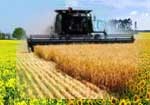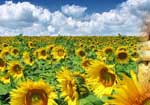






2. Pellets 8mm
3. 6-8 mm DIN+ Quality Pellets
4. We manufacture and sell fuel pellets from straw to European countries
5. Sell wood pellets
6. Wood pellet manufacturing
7. Sunflower Husk Pellets
8. Din Plus Wood Pellets
9. Export of sunflower husk pellets to the European market
10. Export of sunflower husk pellets to the European market
The world's most efficient solar panel
Tue-14-2016
Australian engineers have set a new world record for solar panels with a conversion efficiency of 34.5%.
The solar cell configuration developed at the University of New South Wales nudges closer to the theoretical limits of sunlight-to-electricity conversion.
A device which extracting more solar energy
The photovoltaics record was set by Dr Mark Keevers and Professor Martin Green at UNSW’s Australian Centre for Advanced Photovoltaics.
They used a device which splits incoming rays into four bands to squeeze more electricity from each beam of sunlight.
The result is almost 44% better than the previous record set in the US by Alta Devices with a 24% efficiency.
Keevers says extracting more energy from every beam of sunlight is critical for reducing the cost of electricity from solar cells. The idea is to lower the investment in panels and deliver a return on investment faster.
“Things are moving faster in solar cell efficiency than many experts expected, and that’s good news for solar energy,” he says.
“But we must maintain the pace of photovoltaic research in Australia to ensure that we not only build on such tremendous results, but continue to bring benefits back to Australia.”
Great benefits from multi-junction solar cells
The scientists say Australia’s research in photovoltaics has already generated flow-on benefits of more than $8 billion.
The theoretical limit for a four-junction device used in the UNSW breakthrough is thought to be 53%, which puts the latest result two-thirds of the way there.
These multi-junction solar cells are unlikely to find their way to the rooftops of homes soon because they require more effort to manufacture and cost more than standard crystalline silicon cells.
However, the UNSW team is working on techniques to reduce the manufacturing complexity and create cheaper multi-junction cells.
Source: http://ukrfuel.com/news-here-s-how-australian-scientists-created-104.html
Any copying and distributing withoutactive hyperlink is strictly prohibited!
Views: 2761
 Stobart biomass division is to make a deal
Stobart biomass division is to make a deal
Biomass Related News
- Flexible solar-powered batteries that never need to be recharged
- Ikea invests in renewable energy in UK selling solar panel
- Ukrainian Biofuel Portal assists in purchasing pellets manufactured in Ukraine
- Industrial network on wood pellets
- Cooking with biomass fuels is caused cataracts
- The Valley (Pembrokeshire) Ltd is seeking full planning permission
- The future of biomass-based diesel
- Floating solar panels generating green energy
- Briquettes used in district heating in Floby, Sweden
- Analysis of the Ukrainian market of sunflower husk pellets
|
© Ukrainian Biofuel Suppliers 2008-2024 |
